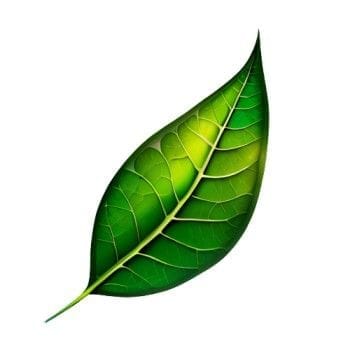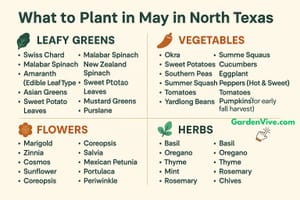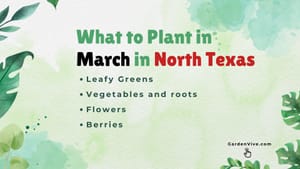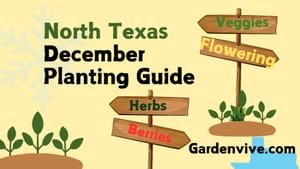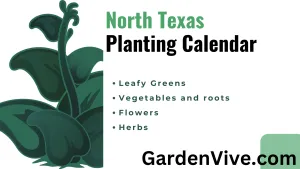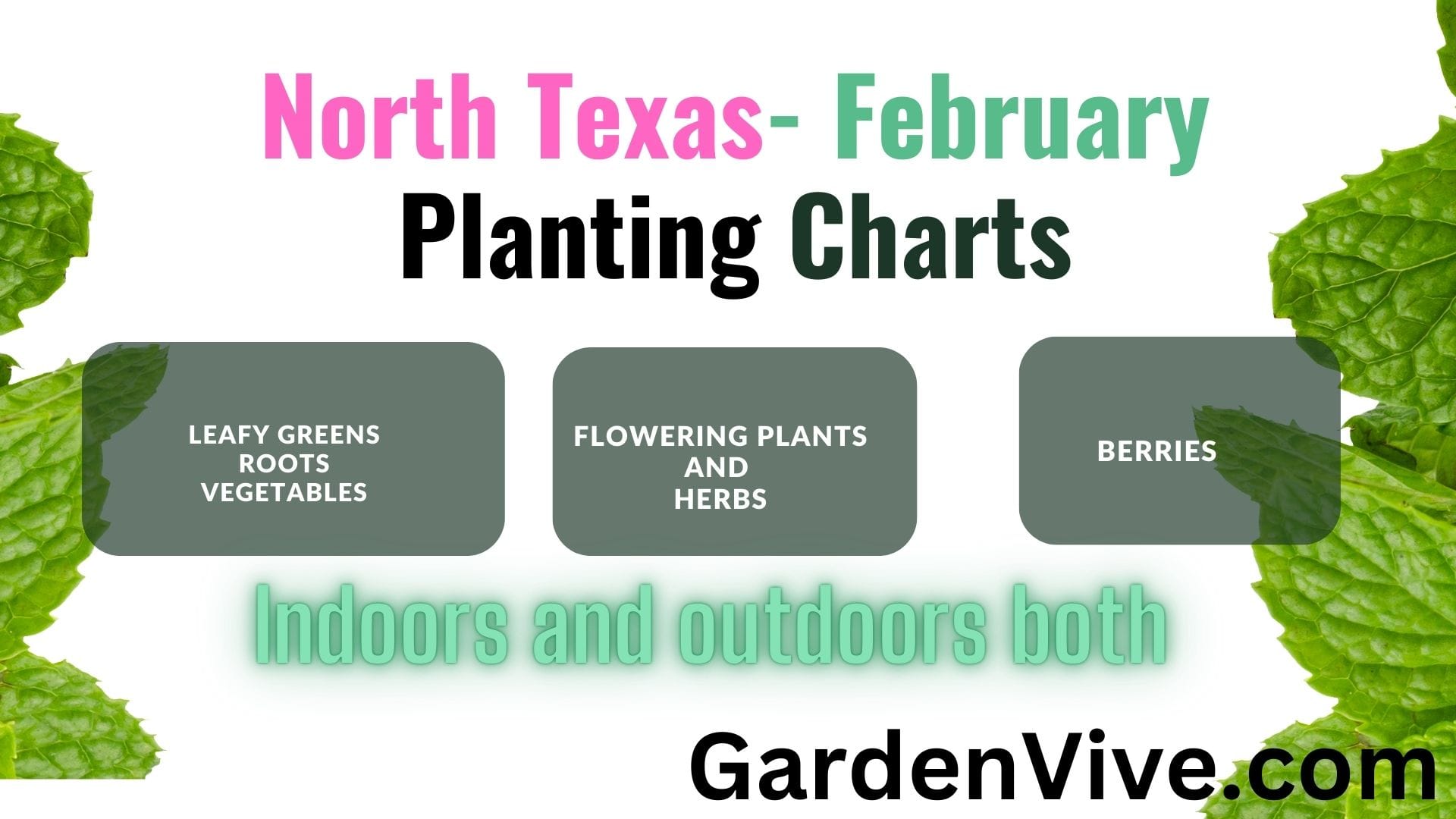
The weather in February in North Texas is somewhat similar to January's. February shows signs of gradual warming as winter transitions into early spring. In this article, you will find what to plant in February in North Texas.
I am considering February's climate and my Grandpa's (85) experience to create these planting charts. My grandpa has lived in North Texas for a long time and I can't take my eyes off his home garden.
The USDA zone of the northmost part of North Texas is Zone 6b and the rest of the major parts are in Zone 7 and Zone 8.
You can check the full-year planting calendar for North Texas, and Zone 7 planting calendar separately if you wish.
North Texas Planting Guide eBook (Buy Now) - In that eBook you will find printable planting charts also.
Some gardeners love to grow their seeds indoors for the upcoming season and some of us love to plant/sow seeds directly outdoors. Considering this fact, I have separated my charts into two major categories.
- Seeds we can start indoors in February.
- What to plant outdoors in February.
Under the major categories, you will find subcategories like:
- Vegetables
- Flowering plants
- Herbs ( You will only find an outdoor planting chart here, as I will not recommend starting them indoors )
- Berries
Seeds to start indoors in February in North Texas
February is a transitional month, and frost is still possible. This is why I have considered the hardiness of the plant to decide what to start indoors and what to plant outdoors.
Note: You may find plants in my chart that you can start indoors and the same plants can be started outdoors in February. ( Due to their extensive growing season )
Vegetable seeds to start indoors
You will find germination time, optimal germination temp. , variety suggestions, and transplanting date range in this single chart.
If not visible on small screens, scroll the table side-wise.
| Plant Name | Germination Time | Optimal Germination Temperature | Variety Suggestions | Transplanting Date Range |
|---|---|---|---|---|
| Tomatoes | 5–10 days | 70–80°F (21–27°C) | Roma, Cherry, Beefsteak | Mid to Late March |
| Peppers | 7–14 days | 75–85°F (24–29°C) | Bell, Jalapeño, Cayenne | Mid to Late March |
| Eggplants | 7–12 days | 75–85°F (24–29°C) | Black Beauty, Ichiban, Fairy Tale | Late March to Early April |
| Broccoli | 5–10 days | 65–75°F (18–24°C) | Calabrese, Green Magic | Late February to Early March |
| Cabbage | 7–12 days | 65–75°F (18–24°C) | Golden Acre, Red Acre | Late February to Early March |
| Cauliflower | 7–12 days | 65–75°F (18–24°C) | Snowball, Graffiti | Late February to Early March |
| Swiss Chard | 7–14 days | 50–75°F (10–24°C) | Bright Lights, Fordhook Giant | Late February to Early March |
| Leeks | 7–14 days | 65–75°F (18–24°C) | American Flag, King Richard | Late February to Early March |
| Onions | 7–12 days | 65–75°F (18–24°C) | Texas Super Sweet, Red Creole | Late February to Early March |
As you can see the list is short. We have experimented with other vegetables but these are the winner.
These vegetable seeds will perform great if you start indoors in February.
In the month of June, your eggplant might be attacked by aphids. In that case, feel free to read: how to get rid of aphids on eggplants.
Flowering seeds
| Plant Name | Germination Time | Optimal Germination Temperature | Perennial or Annual | Transplanting Date Range |
|---|---|---|---|---|
| Petunias | 7–10 days | 70–75°F (21–24°C) | Annual | Late March to Early April |
| Marigolds | 5–7 days | 70–75°F (21–24°C) | Annual | Late March to Early April |
| Zinnias | 5–10 days | 70–75°F (21–24°C) | Annual | Mid to Late March |
| Cosmos | 7–10 days | 65–75°F (18–24°C) | Annual | Late March to Early April |
| Snapdragons | 10–14 days | 60–70°F (15–21°C) | Annual | Late February to Early March |
| Shasta Daisies | 10–14 days | 65–70°F (18–21°C) | Perennial | Late March to Early April |
| Black-Eyed Susans | 7–10 days | 70–75°F (21–24°C) | Perennial | Late March to Early April |
| Lavender | 14–21 days | 65–75°F (18–24°C) | Perennial | Late March to Early April |
| Delphiniums | 10–21 days | 60–65°F (15–18°C) | Perennial | Late March to Early April |
| Sweet Peas | 10–14 days | 55–65°F (13–18°C) | Annual | Late February to Early March |
If you are a fragrant hunter like me, you should go for Lavender and sweet peas. Lavender will win this fragrant battle for sure.
I love planting marigolds in between a few of my veggies as a companion plant. If you want to know what to plant as a companion plant you can check my article: best companion plants for vegetables - Chart
Berries you can start indoors
We can grow many berries from cuttings or transplants. But with proper care, you can grow some of the berries from seeds indoors.
| Plant Name | Germination Time | Optimal Germination Temperature | Variety Suggestions | Transplanting Date Range |
|---|---|---|---|---|
| Strawberries | 14–28 days | 60–70°F (15–21°C) | Albion, Seascape, Quinault | Late March to Early April |
| Blueberries | 30–60 days (requires stratification) | 60–70°F (15–21°C) | Brightwell, Tifblue, Powderblue | Late March to Early April |
| Raspberries | 21–28 days | 65–75°F (18–24°C) | Heritage, Fall Gold, Anne | Late March to Early April |
| Blackberries | 14–28 days | 65–75°F (18–24°C) | Apache, Natchez, Arapaho | Late March to Early April |
| Goji Berries | 7–14 days | 70–85°F (21–29°C) | Sweet Lifeberry, Big Lifeberry | Mid to Late April |
| Cranberries | 21–30 days | 65–70°F (18–21°C) | Stevens, Pilgrim, Ben Lear | Late March to Early April |
| Currants | 14–21 days | 60–70°F (15–21°C) | Red Lake, Blackdown, Consort | Late March to Early April |
| Mulberries | 14–28 days | 70–85°F (21–29°C) | Illinois Everbearing, Pakistan, Shangri-La | Mid to Late April |
Note: It's not that easy to grow all those plants from seeds. If you are a beginner, go for the transplanting method ( you can get it from nurseries ).
What to plant outdoors in February in North Texas
For outdoor planting, we need to keep in mind that February is still cold. All the plants I am listing in the below charts can handle February's cold.
But mother nature is unpredictable sometimes. Do not forget to check weather forecasts frequently.
This chart can help you protect your outdoor plants from cold damage -> When to cover your plants in Winter (Chart)
Vegetables
| Vegetable | Planting Method | Variety Recommendations | Harvesting Time (Days) |
|---|---|---|---|
| Carrots | Direct Sow | Nantes, Danvers Half Long, Scarlet Nantes | 60–80 days |
| Beets | Direct Sow | Detroit Dark Red, Golden Beet, Chioggia | 50–70 days |
| Spinach | Direct Sow | Bloomsdale, Space, Giant Nobel | 30–45 days |
| Broccoli | Transplant | Calabrese, Waltham 29, Green Magic | 50–70 days |
| Cabbage | Transplant | Golden Acre, Red Acre, Savoy | 60–100 days |
| Onions | Transplant or Sets | Texas Early Grano, Candy, Red Creole | 90–120 days |
| Radishes | Direct Sow | Cherry Belle, French Breakfast, White Icicle | 25–30 days |
| Peas | Direct Sow | Wando, Little Marvel, Oregon Sugar Pod | 60–70 days |
| Turnips | Direct Sow | Purple Top White Globe, Tokyo Cross, Hakurei | 30–60 days |
| Swiss Chard | Direct Sow | Bright Lights, Fordhook Giant, Rainbow | 50–60 days |
| Potatoes | Seed Pieces | Red Pontiac, Yukon Gold, Kennebec | 80–100 days |
Flowering Plants
| Flower | Perennial or Annual | Planting Method | Blooming Season | Fragrance |
|---|---|---|---|---|
| Sweet Peas | Annual | Direct Sow | Spring | Yes |
| California Poppies | Annual | Direct Sow | Spring to Early Summer | No |
| Black-Eyed Susans | Perennial | Direct Sow | Summer to Fall | No |
| Snapdragons | Annual | Direct Sow | Spring to Early Summer | No |
| Larkspur | Annual | Direct Sow | Spring | No |
| Columbine | Perennial | Direct Sow | Spring to Early Summer | No |
| Coreopsis | Perennial | Direct Sow | Spring to Summer | No |
| Bluebonnets | Annual | Direct Sow | Spring | No |
| Hollyhocks | Biennial/Perennial | Direct Sow | Summer | No |
| Marigolds | Annual | Direct Sow | Spring to Fall | No |
| Stock | Annual | Direct Sow | Spring | Yes |
| Alyssum | Annual | Direct Sow | Spring to Fall | Yes |
| Dianthus | Perennial | Direct Sow | Spring to Summer | Yes |
| Lavender | Perennial | Direct Sow | Summer | Yes |
| Evening Primrose | Biennial/Perennial | Direct Sow | Spring to Summer | Yes |
| Four O’Clocks | Annual | Direct Sow | Summer | Yes |
Note: Some Four O'clocks flowers do not contain any noticeable fragrance at all.
It's hard to find indoor flowering plants as most of the flowering plants need sunlight to bloom. We have worked hard to create a list of those rare flowers. You can find it here: Flowering plants to grow indoors in North Texas
Herbs
| Herb | Flavor | Perennial or Annual | Planting Method | Variety Suggestions |
|---|---|---|---|---|
| Cilantro | Citrusy, Peppery | Annual | Direct Sow | Slow-Bolt, Santo |
| Chives | Mild Onion Flavor | Perennial | Direct Sow | Garlic Chives, Common Chives |
| Parsley | Herbaceous, Slightly Bitter | Biennial | Direct Sow | Curly, Flat-Leaf |
| Thyme | Earthy, Slightly Minty | Perennial | Direct Sow | English, Lemon |
| Oregano | Pungent, Earthy | Perennial | Direct Sow | Greek, Italian |
| Mint | Cool, Refreshing | Perennial | Direct Sow | Peppermint, Spearmint |
| Rosemary | Piney, Earthy | Perennial | Direct Sow | Arp, Tuscan Blue |
| Sage | Earthy, Peppery | Perennial | Direct Sow | Common, Purple |
| Lavender | Floral, Herbaceous | Perennial | Direct Sow | Munstead, Hidcote |
I have heard some nursery owners suggesting basil to plant in February, but I would never suggest this. February is still cold for basil.
Berries
| Berry | Perennial or Annual | Planting Method | Variety Suggestions | First Harvesting Time (Days) |
|---|---|---|---|---|
| Strawberry | Perennial | Transplant Bare Root Plants | June-bearing, Ever-bearing, Day-neutral | 90–120 days |
| Blueberry | Perennial | Plant Bare Root or Potted Plants | Legacy, Tifblue, Sunshine Blue | 2–3 years |
| Raspberry | Perennial | Transplant Bare Root Plants | Red, Black, Yellow | 60–80 days |
| Blackberry | Perennial | Plant Bare Root or Potted Plants | Triple Crown, Marion, Apache | 60–100 days |
| Goji Berry | Perennial | Transplant Bare Root or Seedlings | Phoenix, Crimson Star | 2–3 years |
| Currant | Perennial | Transplant Bare Root Plants | Red, Black, White | 1–2 years |
| Grape | Perennial | Transplant Bare Root or Potted Plants | Concord, Niagara, Thompson Seedless | 2–3 years |
Do you want to download the printable chart? Just subscribe to this site as a premium member and I will send you the chart to you via email. A free subscription will also be appreciated.
If you find this article helpful, share it with your Texas gardening friends.
